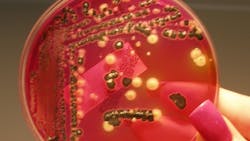Bacteria Produces Intricate Spatial Patterning in 3D Materials
3/30/17: Updates have been made to this article.
3D printing bacterial colonies could lead to intricate spatial patterns in materials not limited to biodegradable plastics, electronics, and adhesives. Scientists are able to engineer bacterial DNA using restrictor enzymes that splice DNA at specific points. By accepting a new sequence of DNA through complementary base-pairing, bacteria can express new customized phenotypes designed by the bioengineer.
Some bacteria can be engineered to metabolize advanced materials like bio-glass or plastics. If exposed to right conditions, the printed bacteria could generate complex patterns in 3D synthetic materials.
Published in ACS Synthetic Biology by a team at the Delft University of Technology in the Netherlands, "A Straightforward Approach to 3D Bacterial Printing" discusses a deposition technique for two engineered bacteria expressing fluorescent proteins. The team designed an affordable bio-printer that can be used to generate high-resolution patterning in 3D substrates.
The team replaced the extruder of a commercial 3D printer with a pipet, and installed proprietary tubing that allows bio-ink extrusion at ambient temperatures, rather than at high temperatures needed to melt and extrude plastic. They used a syringe pump that allows variable flow rates, and added another extruder that could be used to alternate between two bacteria in a single print job. The team says that their technique uses fewer steps than existing printers and preserves life at a higher rate.
The bio-ink consists of alginate and bacteria printed onto agar containing calcium ions. The alginate reacts with the ions to form a biocompatible, crosslinked substrate with a predictable structure. The team tested the biocompatibility of their system by monitoring the strength of fluorescence, which showed proliferation in the colonies over two days.
By using an printing surface with curved and straight edges (think of a track around a football field), the team could assess the uniformity of bio-ink deposition. They found no significant differences in structural spacing on the different paths, and found that they could change the printing resolution by altering the extrusion rate and transverse speed of the printer head.
The team used Tinkercad, which is free online CAD software to control the path if the 3D printer head, and RepRap Slic3r software to analyze layers. They used a digital caliper to measure width and height of printed samples to determine resolution. Plasmid splicing for florescent-protein gene expression was executed in the lab, and is described in the video below.
About the Author
Leah Scully
Associate Content Producer
Leah Scully is a graduate of The College of New Jersey. She has a BS degree in Biomedical Engineering with a mechanical specialization. Leah is responsible for Machine Design’s news items that cover industry trends, research, and applied science and engineering, along with product galleries. Visit her on Facebook, or view her profile on LinkedIn.
